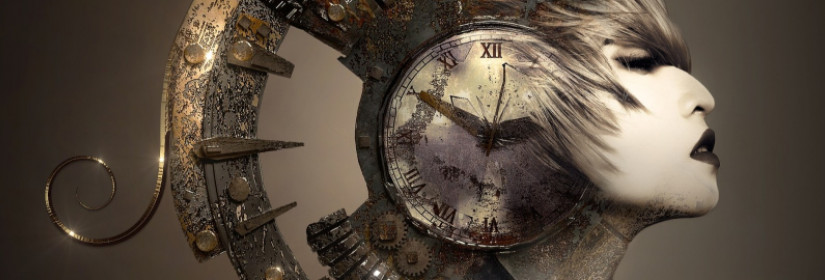Steampunk. Cyberpunk. Dieselpunk. Clockpunk. The more you peruse the bookshelves, the more subgenres you’ll find that end in “punk”. When considering what to write, this can be confusing. So what is the steampunk genre family all about? And how can you make the most of it?
Steampunk Origin: The Rise of the Punks
“Punk” fiction movements started emerging during the 1980s.
The first was cyberpunk, a brand of science fiction concerned with computer technology, social change, and lowlife characters in near-future settings. The term was taken from a 1983 story by Bruce Bethke and popularised following the publication of William Gibson’s novel Neuromancer the following year.
Back then, punk itself was still young, so the title sounded daring. In an age when Top Shop sells Clash t-shirts, it might have lost some of its edge, but it’s still full of potential.
Emerging from the New Wave science fiction of the 1960s and 1970s, cyberpunk incorporated existing works like the 1982 film Bladerunner, as cyberpunk writers built a subgenre juxtaposing technological progress with social breakdown. In its early days, it firmly fitted its title, adopting the harshly-anti-establishment aesthetic of early punk music.
As the genre evolved, that began to wear off. While early works had the driving anger of the Sex Pistols, some later stories have had all the edge of a One Direction single. Just featuring computer programmers could sometimes get you a cyberpunk label.
Next came steampunk. Identified as a genre a few years later, this movement’s title was a knowing reference to cyberpunk. Its main concern was with reinventing Victorian technology, creating alternate histories or entirely new worlds built on 19th-century technology, making steam power evolve in different ways from reality. It was a genre for people who wanted to wear top hats and shout “tally-ho!”
Steampunk fans traced the movement’s origins back to H. G. Wells and Jules Verne, with more modern foundations in the stories of Michael Moorcock, Tim Powers, and K. W. Jeter. For many years, it remained more obscure than cyberpunk, while building a passionate fanbase – some people really like top hats and “tally-ho.” It became a distinct subculture based as much around prop and costume making as it was around fiction.
With these two having set a precedent, other subgenres started using the -punk suffix. Recent years have seen fans and publishers talk about dieselpunk, clockpunk, silkpunk, splatterpunk – seemingly any -punk they thought they could market. The -punk label now indicates a focused genre that gets away from the constraints of reality, usually through reinventing technology. The idea of punk as defiantly anti-establishment is often lost, but what has emerged is no less interesting for it.
What are these different genres about? And how can you use them in your storytelling?
The Cyberpunk Genre
The parent of suffix-punk genres, cyberpunk emerged as a forward-looking form of science fiction. At a time before the internet and a computer in every home, cyberpunk writers predicted a world with those things. This is a genre in which computing and body modification are the central technologies, and their growing importance in reality have made the genre no less relevant.
The aesthetic of cyberpunk is strongly influenced by film noir and the associated American crime fiction. Common features include:
- Criminal protagonists, especially hackers
- Corrupt law enforcement
- Power lying with corporations, not governments
- Huge disparities in wealth
- Readers looking uncomfortable as the news catches up with their favorite novels
Cyberpunk foresaw important social, economic, and technological trends and has continued to engage with them. In its worlds, national governments are increasingly weak, the real power lying with corporations. Life is uncertain, the truth hard to find, and a technologically-connected world creates as many problems as it solves. It’s a cynical genre, not one to curl up with for a cozy comfortable read.
Cyberpunk is a great genre if you want to write about any of the following:
- The near future
- Globalization
- Corporate power
- Realistic prospects for current technological trends
- Anti-heroes
If you like the idea of morally bankrupt characters committing dark deeds on streets soaked by acid rain, then cyberpunk is probably for you.
Looking for some cyberpunk inspiration? Try writing about:
- Cybercriminals trying to steal a country
- A hard-drinking detective with a computer where half his brain should be
- How current news headlines could be connected by an elaborate corporate conspiracy
The Steampunk Genre
Steampunk is about reinventing 19th-century technology and the world around it. Imagine if Babbage’s calculating engines had birthed a world of mechanical computers; if airship travel had become common; if steam-powered machines were in every office and home. What you’re imagining is steampunk.
Though technology is important in the steampunk genre, so are the manners and culture of the time. Authors in this genre often adopt a Victorian aesthetic or twist and exaggerate it into something new. Top hats, tailcoats, and bustles are the order of the day. Ladies and gentlemen sip tea and exchange barbed pleasantries. It’s all about the fancy dress, with an emphasis on the “fancy.”
Because of this aesthetic, the focus is often on relatively well-to-do characters. There are regular exceptions, showing the mechanics, laborers, and soldiers whose hard work made 19th-century elegance possible. Just don’t think too hard about what their lives were really like, unless you want to end up crying into your keyboard.
Steampunk fiction is tied to a broader steampunk subculture, in which people make props and costumes fitting the genre, meet up to share their creations, and engage in Victorian-inspired pastimes like tea dueling (yes, that’s every bit as silly as it sounds, which is why people do it).
Because of this maker-flavored subculture and the interest in old technology, steampunk celebrates invention. Its protagonists are often goggle-wearing gadgeteers capable of making new machines from a pile of gears and pistons.
In publishing, the edges of the steampunk genre have become increasingly blurred. A lot of fantasy elements bleed into steampunk. Some fantasy novels with a 19th-century aesthetic but no technological element sell themselves as this genre. Purists rage against stories that aren’t “really steampunk,” as if the presence of elves somehow makes steam-powered robot stories less plausible.
The Steampunk genre is a good fit if you want to write:
- Offbeat pulp adventures. My own Epiphany Club stories have everything from ninjas to a hot air balloon chase.
- Romances full of historical whimsy, a common thread in Gail Carriger’s work.
- Manners and technology pushed to absurd extremes.
- Stories that celebrate technology without digging too deeply into its downside.
- Anything with airships.
Not sure where to start with a steampunk story? Try writing about:
- A steam-powered version of the internet
- Aristocratic explorers whose airship crash-lands in a lost civilization of Aztec machines
- A mad Victorian inventor trying to bring a factory to life
Retrofutures
As steampunk has grown in popularity, a lot of writers have reimagined where past technology could have led. This has fostered a range of retro-futurist genres, in which the technology of different times and places is adapted in different ways.
One of the most prominent of these is dieselpunk. It takes the technology and culture of the 1920s to 1940s as its starting point, retaining the era’s aesthetic but using it in new ways. This includes:
- Weird versions of World War Two
- Reinventions of pulp science fiction imagery
- Exaggerated takes on the decadence of the Roaring Twenties
As an author, dieselpunk lets you explore two extremes – the bright, shiny potential of the jazz age and the pre-space-age space adventures; or the grime and hardship of heavy industry and global warfare. It tends more towards the gritty than steampunk does, letting you explore a less shiny sort of retro-future. Using the 1940s can get into some difficult issues, given the nature of the Second World War, but you can’t make an omelet without having awkward conversations about the eggs.
Clockpunk takes a similar approach to Renaissance-era technology, using machines driven by clockwork and springs. It often merges with the more popular Renaissance fantasy subgenre. Not as popular as dieselpunk, it shows how any different era can be used to create interesting alternatives to reality. By freezing the progress of underlying technology and instead applying the tools and style of an age in new and unexpected ways, unfamiliar worlds emerge.
While the focus of many of these movements has been on exploring different eras, silkpunk spins things off through a geographical shift. A term coined by Ken Liu to describe his own books, this involves using the technology of classical East Asia and the Pacific instead of the European technologies common to steampunk, dieselpunk, and clockpunk. And when you’re as gifted as Ken Liu, you can get away with inventing your own genre.
Because these technologies are more grounded in the organic, and because of the cultures they come from, silkpunk creates a very different aesthetic from the Eurocentric alternatives. For a writer who wants to represent the wonderful variety of our world or to counter the hegemony of western style in genre fiction, it points the way to diverse and fascinating alternatives.
If you want to create your own retrofuture, how about:
- Bronzepunk: Create an ancient Greece full of steam-powered spearmen and computers based on the Antikythera device.
- Frankenpunk: 18th-century scientists can stitch together strange creatures in a Frankenstein style. What will they do with them?
Other Punks
While the -punk suffix is becoming increasingly synonymous with retro-futurist fiction, it’s also used for a range of other subgenres.
Biopunk grew out of cyberpunk, exploring the potential of biological, rather than digital, technology. Concerned with synthetic biology, DNA programming, and human experimentation, it retains cyberpunk’s cynicism and concerns about corporate power. This is fiction full of potential for body horror, as people find themselves transformed. With so many of cyberpunk’s predictions having become a reality, it’s also a way to write something more offbeat set in the near future. Think brain hacking, gene splicing, and diet supplements gone wrong.
Nanopunk is an even more obscure derivative of cyberpunk, exploring the potential of nanotechnology. Again, it’s a space that’s great for writers who want to explore the impending future without focusing on computers, which have now become too familiar to provide novelty.
Outside of technological stories lies splatterpunk. A movement in horror fiction, it combines the countercultural demands of early punk music with graphic violence. It emerged in the 1980s as authors, film-makers, and audiences pushed their genre towards extremes. But, while it influenced the wider horror field, it declined as a movement in the 1990s.
Splatterpunk has recently seen a revival, as self-publishing and social media have allowed authors to create extreme content and find an audience for it. Though a very different sort of -punk subgenre from the rest, it shares their desire to push a particular aesthetic to extremes. It’s a good outlet for the writer who wants to revel in blood and darkness.
New -punk subgenres seem to emerge every year. What they share is a narrowing of focus onto a particular aesthetic, encouraging writers to explore the implications of a technology or style. They can provide you with the tools and inspiration for interesting fiction, especially stories exploring the relationship between technology and society.
Like any good subgenre, they’re useful for finding an audience. Whatever -punk you work in, there will be readers out there searching for it. By showing them where in this rich spectrum you fall, you can help them to realize why they should be reading your work.




